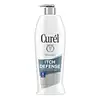What's inside
What's inside
 Key Ingredients
Key Ingredients

 Benefits
Benefits

 Concerns
Concerns

 Ingredients Side-by-side
Ingredients Side-by-side

Water
Skin ConditioningGlycerin
HumectantUrea
BufferingCetearyl Alcohol
EmollientGlyceryl Glucoside
HumectantCyclomethicone
EmollientSodium Lactate
BufferingButyrospermum Parkii Butter
Skin ConditioningCaprylic/Capric Triglyceride
MaskingDicaprylyl Ether
EmollientMethylpropanediol
SolventOctyldodecanol
EmollientTapioca Starch
Glyceryl Stearate Se
EmulsifyingHydrogenated Coco-Glycerides
Emollient1,2-Hexanediol
Skin ConditioningArginine Hcl
Skin ConditioningSodium Chloride
MaskingSodium PCA
HumectantDimethiconol
EmollientPhenoxyethanol
PreservativeLactic Acid
BufferingSodium Cetearyl Sulfate
CleansingChondrus Crispus Extract
Skin ConditioningCarnitine
CleansingMannitol
HumectantSerine
MaskingSucrose
HumectantCeramide NP
Skin ConditioningCitrulline
Skin ConditioningGlycogen
HumectantHistidine Hcl
Skin ConditioningAlanine
MaskingThreonine
Glutamic Acid
HumectantLysine
Skin ConditioningWater, Glycerin, Urea, Cetearyl Alcohol, Glyceryl Glucoside, Cyclomethicone, Sodium Lactate, Butyrospermum Parkii Butter, Caprylic/Capric Triglyceride, Dicaprylyl Ether, Methylpropanediol, Octyldodecanol, Tapioca Starch, Glyceryl Stearate Se, Hydrogenated Coco-Glycerides, 1,2-Hexanediol, Arginine Hcl, Sodium Chloride, Sodium PCA, Dimethiconol, Phenoxyethanol, Lactic Acid, Sodium Cetearyl Sulfate, Chondrus Crispus Extract, Carnitine, Mannitol, Serine, Sucrose, Ceramide NP, Citrulline, Glycogen, Histidine Hcl, Alanine, Threonine, Glutamic Acid, Lysine
Water
Skin ConditioningGlycerin
HumectantPetrolatum
EmollientTapioca Starch
Cetearyl Alcohol
EmollientPEG/PPG-17/6 Copolymer
SolventDimethicone
EmollientBehentrimonium Chloride
PreservativeIsopropyl Palmitate
EmollientPPG-15 Stearyl Ether
EmollientPropylene Glycol Isostearate
Skin ConditioningPanthenol
Skin ConditioningIsopropyl Alcohol
SolventMethylparaben
PreservativeBenzalkonium Chloride
AntimicrobialEthylparaben
PreservativeOlea Europaea Fruit Oil
MaskingCetyl-Pg Hydroxyethyl Palmitamide
Skin ConditioningBis-Methoxypropylamido Isodocosane
EmollientButyrospermum Parkii Butter
Skin ConditioningSodium Lauroyl Lactylate
EmulsifyingTocopheryl Acetate
AntioxidantCeramide NP
Skin ConditioningCeramide AP
Skin ConditioningCholesterol
EmollientPhytosphingosine
Skin ConditioningCarbomer
Emulsion StabilisingXanthan Gum
EmulsifyingCeramide EOP
Skin ConditioningWater, Glycerin, Petrolatum, Tapioca Starch, Cetearyl Alcohol, PEG/PPG-17/6 Copolymer, Dimethicone, Behentrimonium Chloride, Isopropyl Palmitate, PPG-15 Stearyl Ether, Propylene Glycol Isostearate, Panthenol, Isopropyl Alcohol, Methylparaben, Benzalkonium Chloride, Ethylparaben, Olea Europaea Fruit Oil, Cetyl-Pg Hydroxyethyl Palmitamide, Bis-Methoxypropylamido Isodocosane, Butyrospermum Parkii Butter, Sodium Lauroyl Lactylate, Tocopheryl Acetate, Ceramide NP, Ceramide AP, Cholesterol, Phytosphingosine, Carbomer, Xanthan Gum, Ceramide EOP
Ingredients Explained
These ingredients are found in both products.
Ingredients higher up in an ingredient list are typically present in a larger amount.
This ingredient is also known as shea butter. It is an effective skin hydrator and emollient.
Emollients help soothe and soften your skin. It does this by creating a protective film on your skin. This barrier helps trap moisture and keeps your skin hydrated. Emollients may be effective at treating dry or itchy skin.
Shea butter is rich in antioxidants. Antioxidants help fight free-radicals, or molecules that may harm the body. It is also full of fatty acids including stearic acid and linoleic acid. These acids help replenish the skin and keep skin moisturized.
While Shea Butter has an SPF rating of about 3-4, it is not a sunscreen replacement.
Shea butter may not be fungal acne safe. We recommend speaking with a professional if you have any concerns.
Learn more about Butyrospermum Parkii ButterCeramide NP is a type of ceramide and formally known as ceramide 3.
Ceramides are intercellular lipids naturally found in our skin that bonds dead skin cells together to create a barrier. They are known for their ability to hold water and thus are a great ingredient for dry skin.
Ceramides are an important building block for our skin barrier. A stronger barrier helps the skin look more firm and hydrated. By bolstering the skin ceramides act as a barrier against irritating ingredients. This can help with inflammation as well.
If you would like to eat ceramides, sweet potatoes contain a small amount.
Read more about other common types of ceramides here:
Ceramide AP
Ceramide EOP
Cetearyl alcohol is a mixture of two fatty alcohols: cetyl alcohol and stearyl alcohol. It is mainly used as an emulsifier. Emulsifiers help prevent the separation of oils and products. Due to its composition, it can also be used to thicken a product or help create foam.
Cetearyl alcohol is an emollient. Emollients help soothe and hydrate the skin by trapping moisture.
Studies show Cetearyl alcohol is non-toxic and non-irritating. The FDA allows products labeled "alcohol-free" to have fatty alcohols.
This ingredient is usually derived from plant oils such as palm, vegetable, or coconut oils. There is debate on whether this ingredient will cause acne.
Due to the fatty acid base, this ingredient may not be Malassezia folliculitis safe.
Learn more about Cetearyl AlcoholGlycerin is already naturally found in your skin. It helps moisturize and protect your skin.
A study from 2016 found glycerin to be more effective as a humectant than AHAs and hyaluronic acid.
As a humectant, it helps the skin stay hydrated by pulling moisture to your skin. The low molecular weight of glycerin allows it to pull moisture into the deeper layers of your skin.
Hydrated skin improves your skin barrier; Your skin barrier helps protect against irritants and bacteria.
Glycerin has also been found to have antimicrobial and antiviral properties. Due to these properties, glycerin is often used in wound and burn treatments.
In cosmetics, glycerin is usually derived from plants such as soybean or palm. However, it can also be sourced from animals, such as tallow or animal fat.
This ingredient is organic, colorless, odorless, and non-toxic.
Glycerin is the name for this ingredient in American English. British English uses Glycerol/Glycerine.
Learn more about GlycerinTapioca starch is a thickening agent and is made from the cassava root, also known as yucca.
According to a manufacturer, it is an excellent talc replacement.
It is gluten-free.
Learn more about Tapioca StarchWater. It's the most common cosmetic ingredient of all. You'll usually see it at the top of ingredient lists, meaning that it makes up the largest part of the product.
So why is it so popular? Water most often acts as a solvent - this means that it helps dissolve other ingredients into the formulation.
You'll also recognize water as that liquid we all need to stay alive. If you see this, drink a glass of water. Stay hydrated!
Learn more about Water